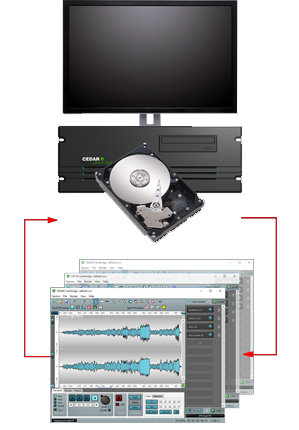Background Processing
Imagine the scenario: you switch on your CEDAR Cambridge system, access a file, load the processes you need, and determine the parameters that offer the best results. In the past, you then processed the audio in real-time or pressed Render and waited for processing to be completed before you could move on. But with the CAM/SP server pack, you simply place the current instance of CEDAR Cambridge into background mode, whereupon the system will render it as and when processing power is available to do so.
You are now free invoke a second instance of CEDAR Cambridge on the same host system. Having done so, you can load another file and, in the foreground, work out the parameters that offer the best results. You don't even have to use the same audio processes as before; you are free to create a completely new signal chain if you wish. When you have done so, you place job #2 into background mode, invoke a third instance of CEDAR Cambridge and move onto job #3, and so on.

At this point, you may be wondering whether the first job needs to be completed before the background processing mode will accept job #2. It doesn't. CEDAR Cambridge allows you to launch multiple instances of the entire system so you can keep setting up jobs and placing them in the background, right up to the limit of the hardware to handle them. What's more, every instance of CEDAR Cambridge is independent of all the others, with separate processing chains and independent parameters for each.
Background processing increases ease of use and productivity, and is a boon for users handling large volumes of audio.







